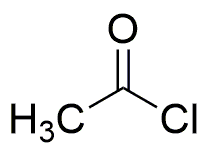Acetyl chloride is widely utilized in research focused on:
- Synthesis of Acetylated Compounds: It serves as a key reagent in the synthesis of acetylated derivatives, which are important in pharmaceuticals and agrochemicals.
- Production of Esters: Acetyl chloride is used to produce esters through esterification reactions, benefiting the food and fragrance industries by creating flavoring agents and fragrances.
- Polymer Chemistry: It acts as a catalyst in the production of various polymers, enhancing properties such as flexibility and durability, which are crucial in manufacturing plastics and coatings.
- Laboratory Reactions: In organic synthesis, it is employed for introducing acetyl groups into molecules, facilitating the study of reaction mechanisms and compound behavior in research settings.
- Pharmaceutical Applications: Acetyl chloride is used in the synthesis of active pharmaceutical ingredients (APIs), providing a pathway to create more effective medications with improved bioavailability.
General Information
Properties
Safety and Regulations
Applications
Acetyl chloride is widely utilized in research focused on:
- Synthesis of Acetylated Compounds: It serves as a key reagent in the synthesis of acetylated derivatives, which are important in pharmaceuticals and agrochemicals.
- Production of Esters: Acetyl chloride is used to produce esters through esterification reactions, benefiting the food and fragrance industries by creating flavoring agents and fragrances.
- Polymer Chemistry: It acts as a catalyst in the production of various polymers, enhancing properties such as flexibility and durability, which are crucial in manufacturing plastics and coatings.
- Laboratory Reactions: In organic synthesis, it is employed for introducing acetyl groups into molecules, facilitating the study of reaction mechanisms and compound behavior in research settings.
- Pharmaceutical Applications: Acetyl chloride is used in the synthesis of active pharmaceutical ingredients (APIs), providing a pathway to create more effective medications with improved bioavailability.
Documents
Safety Data Sheets (SDS)
The SDS provides comprehensive safety information on handling, storage, and disposal of the product.
Product Specification (PS)
The PS provides a comprehensive breakdown of the product’s properties, including chemical composition, physical state, purity, and storage requirements. It also details acceptable quality ranges and the product's intended applications.
Certificates of Analysis (COA)
Search for Certificates of Analysis (COA) by entering the products Lot Number. Lot and Batch Numbers can be found on a product’s label following the words ‘Lot’ or ‘Batch’.
*Catalog Number
*Lot Number
Certificates Of Origin (COO)
This COO confirms the country where the product was manufactured, and also details the materials and components used in it and whether it is derived from natural, synthetic, or other specific sources. This certificate may be required for customs, trade, and regulatory compliance.
*Catalog Number
*Lot Number
Safety Data Sheets (SDS)
The SDS provides comprehensive safety information on handling, storage, and disposal of the product.
DownloadProduct Specification (PS)
The PS provides a comprehensive breakdown of the product’s properties, including chemical composition, physical state, purity, and storage requirements. It also details acceptable quality ranges and the product's intended applications.
DownloadCertificates of Analysis (COA)
Search for Certificates of Analysis (COA) by entering the products Lot Number. Lot and Batch Numbers can be found on a product’s label following the words ‘Lot’ or ‘Batch’.
*Catalog Number
*Lot Number
Certificates Of Origin (COO)
This COO confirms the country where the product was manufactured, and also details the materials and components used in it and whether it is derived from natural, synthetic, or other specific sources. This certificate may be required for customs, trade, and regulatory compliance.


